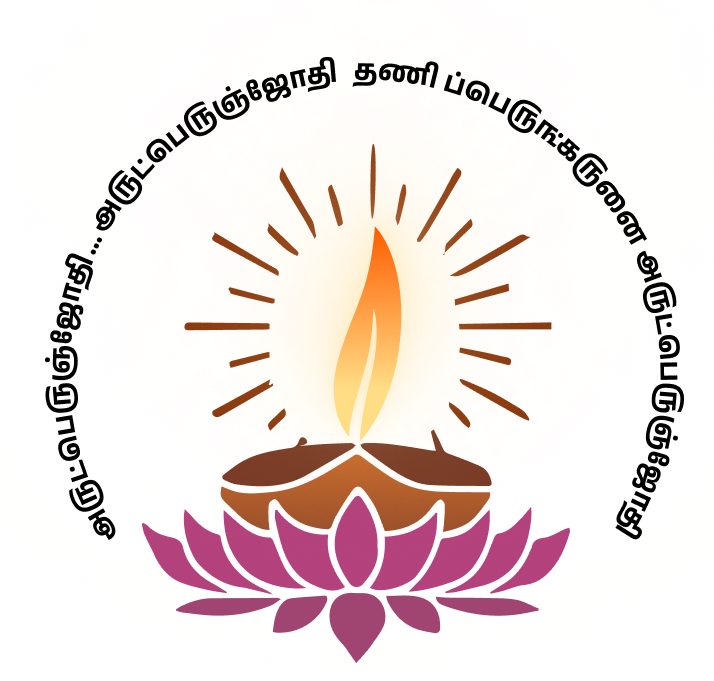One of the most well-known Tamil Saints was Arutprakasa Vallalar Chidambaram Ramalingam whose pre-monastic name was Ramalingam. He also belonged to a line of Tamil saints known as “gnana siddhars”, who were among the greatest poets in Tamil throughout the 19th century.
Vallalar, who was born in 1823 close to Chidambaram in Tamil Nadu, India, spent his early years there until moving to Vadalur in 1867. He sensed a divine calling to serve as the earth’s representative and as the Divine’s tool for the earth’s universal manifestation of the death-defeating Vast Grace-Light. Following its Manifestation, he perceived a divine progression of earthly life. His body changed and became so completely filled with Light as a result of his integral realisation of the supreme and global Divine that it no longer cast any shadows on the ground.
He is also referred to as Vallalar, Ramalinga Swamigal, or Ramalinga Adigal in India and other countries. He also belonged to a line of Tamil saints known as “gnana siddhars” (gnana indicating greater wisdom), who were among the greatest poets in Tamil throughout the 19th century.The Samarasa Suddha Sanmarga Sathya Sangam (The Unified Pure Path of Absolute Truth) was spread and passed on by him not only in theory but especially in practice by his way of living which is an inspiration for his followers. Through the notion of Suddha Sanmarga Sangam (pure path of absolute truth), the saint endeavored to eliminate the caste system. According to Suddha Sanmarga, the prime aspects of human life should be love, connected with charity and divine practice, leading to pure knowledge. Ramalinga advocated the concept of worshipping the flame of a lighted lamp as a symbol of the Eternal Power.
CHILDHOOD
Ramalingam and his parents once visited the Chidambaram Natarajar Temple when he was 5 months old. The Deepa Aaradhana offered by the priest was perceived as a deep spiritual experience by him. In later years, he stated his experience as “No sooner the Light was perceived, happiness prevailed on me”. In 1824, his father passed away and he was forced to move to Madras (Chennai) in 1826. His formal education was initiated by his brother Sabhapathi when he was 5 years old. Not being interested in formal education, Adigalar performed at the nearby Kandha Kottam Kandha Swami temple. Later, he started meditating by concentrating on the lighted lamp and thus began his spiritual life. It is believed that Ramalingam renounced the world at the age of 13.
Ramalingam left Chennai in 1858 and went to Chidambaram. Then Ramalingam went to Ramakrishna Reddiyar’s house at Karunguzhi, Vadalur and stayed there for 9 years. Ramalingam was against the caste system due to its adverse impact on society. He started the “Samarasa Vedha Sanmarga Sangam” in 1865 which was renamed as “Samarasa Suddha Sanmarga Sathya Sangam” in 1872. Ramalingam was influenced by Valluvar’s Tirukkural from a young age and started preaching them. He vowed to follow Valluvar’s morals of compassion and non-violence and continued emphasizing on non-killing and meatless way of life by his concept of Jeeva Karunyam.
TEACHINGS
In 1867, Ramalingam established the “Sathya Dharma Salai” in Vadalur for serving the poor. On inaugural day, fire on stone stove was lit by him with a declaration that the fire be ever alive and the needy shall be fed forever. The facility still continues to serve food to people, without discrimination.
In 1872, Ramalingam started the “Sathya Gnana Sabha” in Vadalur. One of his primary teaching was “Service to Living Being is the path of Liberation/ Moksha”. He stated God as “Arul Perum Jothi” referring as personification of Grace and knowledge. He also established the “Sathya Gnana Sabai” which was open to everyone except non-vegetarians. He suggested that people below the age of 12 and above the age of 72 were expected to enter and perform poojas in the Gnana Sabai. The oil lamp lit by him is kept perpetually burning.
LITERARY WORKS
As a musician and poet, Ramalingam composed 5818 poems preaching universal love and peace, compiled into ‘6 Thiru Muraigal’. Today, the compilation is available as a single book called Thiruvarutpa.
His other work are
◦ Manumurai Kanda Vasagam, describing the life of Manu Needhi Cholan
◦ Jeeva Karunya Ozhukkam
DISAPPEARANCE
On 30 January 1874, Ramalingam entered his one-room residence Siddhi Valagam and locked himself inside, asking his followers not to open it. Government forced the doors open in May to find the room being empty. In 1906, records about his disappearance were published in the South Arcot District’s Madras District Gazetteers.



